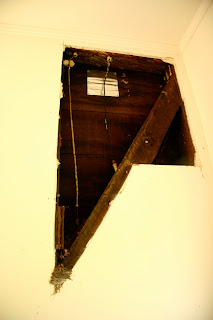Philip showed up this morning to extract the swarm from the wall in my office. I asked him if we could have an audience since friends and neighbors all expressed interest. I think he was a little taken aback by the human swarm that was pressed into my little apartment. We all promised to be quiet and stay out of the way, but the excitement was palpable. Charley had been problem solving the easiest and tidiest way to remove the drywall and keep my office clean, but Philip thought he could handle it. I wish I had insisted on letting Charley do the prep work because the place was a sticky dusty mess at the end and that could have been prevented.
The amazing thing is that the bees were not disturbed by the sound or vibration of an electric jigsaw cutting into their home. When Philip removed the square of drywall and exposed the nest the bees flew up en masse for a second and then settled peacefully back into their routine.
Look at how much they built in three weeks. They picked a space that was too cramped and probably would have had to move out in a few more weeks. What you are looking to the left is the brand new fresh white comb they are building to make room for more brood. To the right is the newly capped off brood, the golden sandy colored area. They are already capping off honey in the upper right of the nest. This queen is very productive! A good sign for us.

I did not take any pictures during the removal because I was helping Philip vacuum up the bees and gently cut out and remove the comb as carefully as possible. We put the brood and honey filled comb into 5 gallon plastic buckets and he vacuumed the bees up into a screened wooden box using a modified low horsepower shop vac motor and hose. It is strong enough to suck them off the comb but gentle enough not to harm them. There is always a concern in these extractions that the queen may be lost, harmed or that she will simply fly away in the confusion. But since there were plenty of freshly laid eggs (three days old or less) the colony would be able to make a new queen if necessary. But hopefully, she would be right there in the middle of the cluster of bees in the screened box.

There was a little scare as the last comb came out. An old exposed electric wire from probably 50 years ago became visible and Philip saw his life flash before his eyes. The wire was not live and probably had been disconnected for decades, but he was not amused.
After the entire colony and all the comb was removed, Charley screwed a metal plate over the hole so the field bees would not keep trying to get into the knothole and end up flying all around my apartment looking for their lost home.
Philip pointed out that there was some very old comb down at the bottom along with some mouse poop and nesting materials. He suggested that there had been a colony in this same spot years ago and that a happy mouse had used it as a home after that.
The bees left beautiful patterns of wax on the dark old wood. I wish I had more time to photograph it, but we had a lot of work ahead of us. The nest was cleared out of my wall, the brood was waiting in buckets to be fastened into empty frames, and the bees were anxious to be reunited with their home.
The field bees did their best to get into the blocked up hole and some of them succeeded in squeezing their little bodies in between the wood and the metal. I ended up with about 100 loose bees floating around in the office banging against the windows trying to figure out what the heck happened.
Much to my surprise and dismay, Philip packed up his gear and cleared out as soon as I paid him, leaving a huge mess of honey footprints and hand prints all over the carpet and walls and drywall dust on my desk and computer and couch. I guess I should have asked him to be more specific about what exactly the service entailed. I just assumed it included cleaning up after the main part of the job. I was surprised that he left such a mess. I won't be able to recommend him now to anyone else in the same predicament.
Next up...setting up the hive box for the bees new home.

















